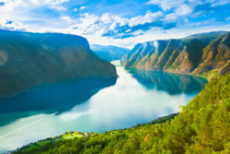
Norway’s longest and deepest fjord, the Sognefjord, reaches more than 200 kilometers inland to the Jotunheimen and Jostedalsbreen national parks. The largest glacier on the European peninsula, Jostedalsbreen, covers about half of Jostedalsbreen National Park. This national park is different from others because it has so many different ecosystems in a small area. The landscape is spectacular and welcoming, and there are plenty of fascinating and revitalizing things to do here for the whole family. The cities of Aurland, Laerdal, Ardal, Sogndal, Luster, Leikanger, Balestrand, Vik, and Hoyanger are all part of the Sognefjord Region. Some of the minor fjords that radiate out from Sognefjorden include the Sognesjoen, Lifjorden, Hoyangsfjord, Arnafjord, Esefjord, Fjaerlandsfjord, Sogndalsfjord, Aurlandsfjord, Naeroyfjord, Laerdalsfjord, Ardalsfjord, and Lustrafjord.
The ice age and following climate changes carved out Sognefjord. The area’s steep mountains and deep valleys were formed as continental glaciers melted. A population based on farming the land settled in the fjords and mountains.
In the Sognefjord region, the strength of nature and everything associated with it is the main draw. With its broadest and narrowest fjords, lush valleys, towering mountain ranges, and blue glaciers, Sognefjord boasts a diverse array of natural wonders. There are also lonely mountain farms, charming, scenic fruit-growing communities, and modern cities.
Some fascinating national cultural assets can be found in Sognefjord as well. The area is home to five of Norway’s oldest stave churches, the oldest of which (Urnes) is listed as a World Heritage Site by UNESCO.